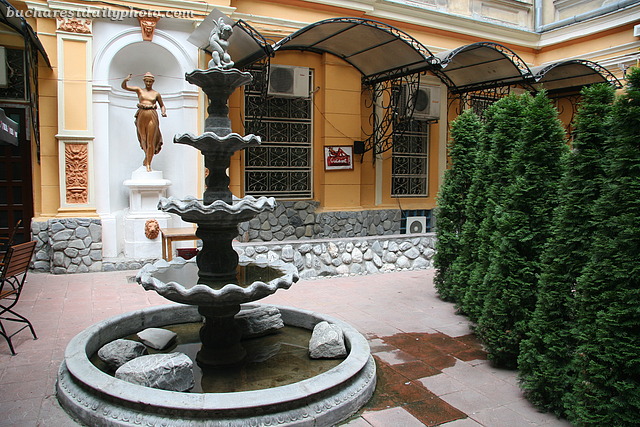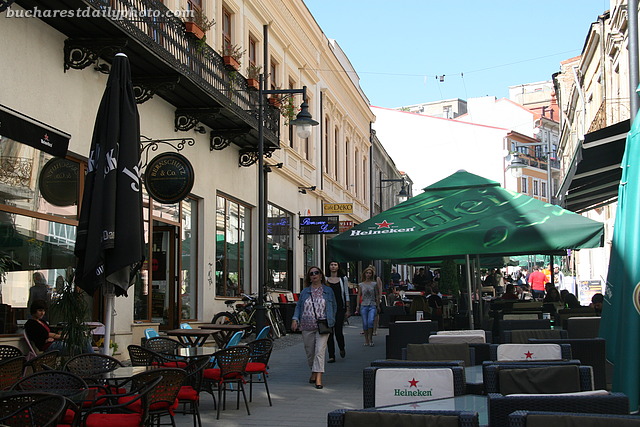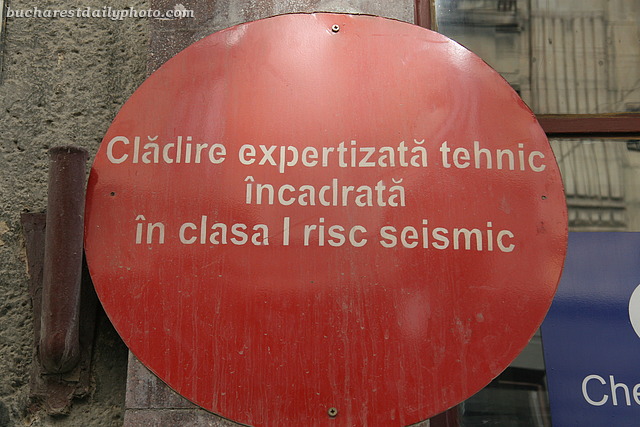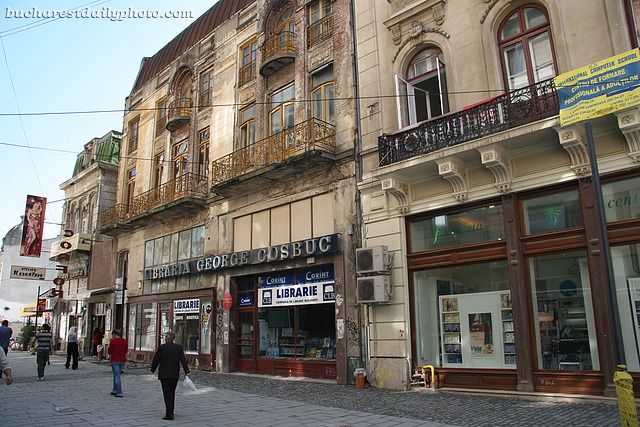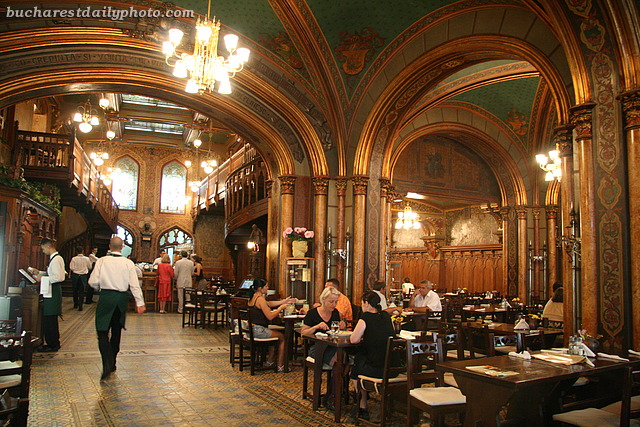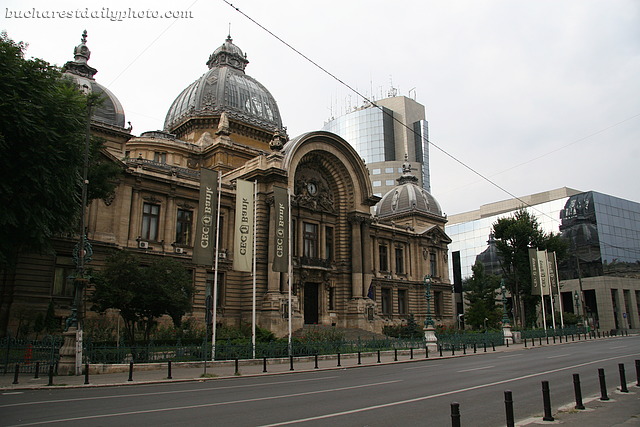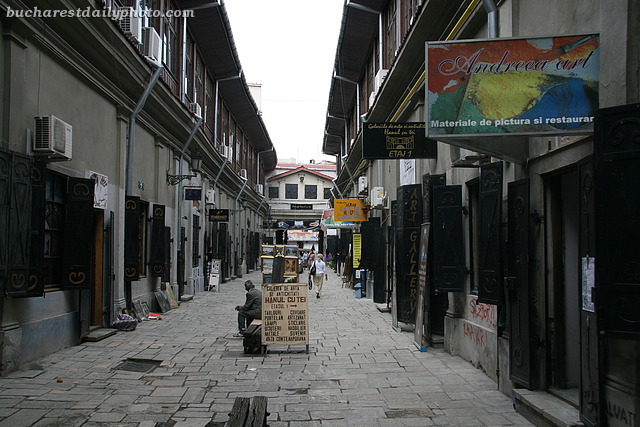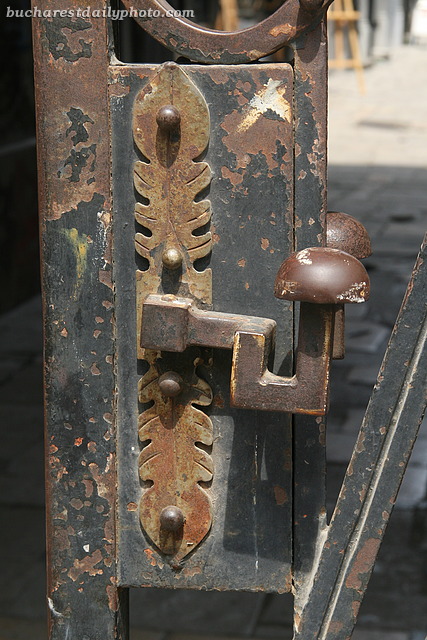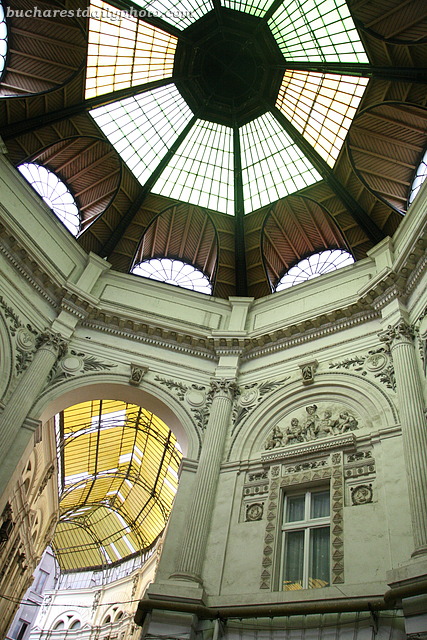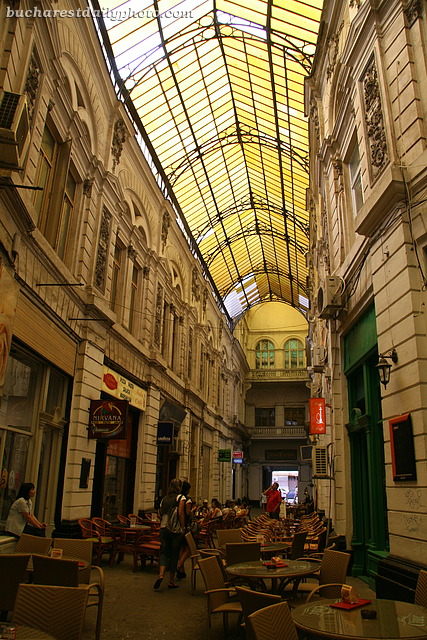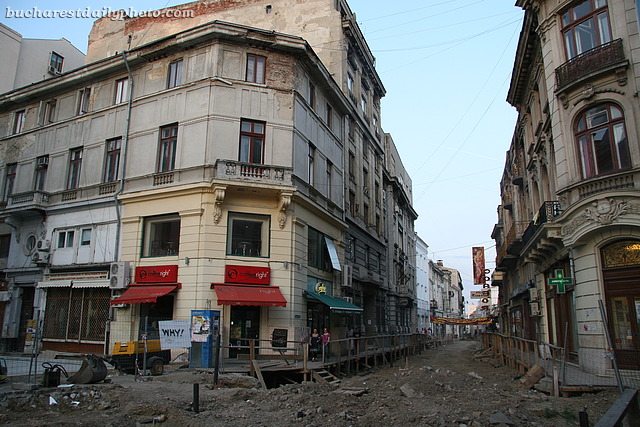To be honest I didn’t know the place in today’s photo existed until a few weeks ago. I must have passed the entrance to this inner courtyard a thousand times but it never crossed my mind to take the few steps through the entrance passageway. But last time I passed this building I stopped to take a picture of the marble plaque that identifies the building as “the house where the poet Mihai Eminescu (who is considered Romania’s greatest poet) worked as an editor to the newspaper The Time between the years 1877 – 1879″ and decided to see what’s behind the narrow passage to the right of the plaque. What I found was this nice inner courtyard, with a fountain and a bronze statue. The building that forms the inner courtyard used to belong to the Dacia Insurance Company and it was built in 1874.
After a gloomy weekend, the sun decided to make an appearance on Monday, which turned out to be a pretty beautiful day. In the afternoon I went out to enjoy the sun and saw that the city was buzzing with people enjoying the nice weather. On my stroll around the old town I noticed the terraces on Smârdan were just starting to fill up. On a previous post I was talking about the on-going renovation of the Old Town. Even though the project is far from being over, this year the Old Town saw an explosion of new cafes, bars, clubs and restaurants. Many of these new establishments lie on Smârdan Street, which is the subject of my photo of the day. Smârdan has already been repaved and all summer it served as one of the favourite evening meeting places in Bucharest. Compared to other outing areas of Bucharest the neighborhood still has a laid back vibe that I like. Trying to navigate the street on a Saturday night proves a mighty task because tables fill the street wall to wall.
I wrote yesterday about the red dot and I thought a good idea to post a close up of it. Like I said, it reads “This building has been appraised by technical expertise to fall within seismic risk class I” and this means high risk of collapse in case of an earthquake of magnitude 7 of higher on Richter scale. Many of the historical buildings of Bucharest were built before World War II and were never reinforced. Some of them don’t have a foundation or have very shallow foundations and have already been through two major earthquakes (the one in 1977 and another one in 1940 of magnitude 7.7). After the 1977 earthquake, the government imposed tougher construction standards. Earthquake is always on the minds of citizens of Bucharest and people always ask if the building “has a dot” when looking for an apartment. Evidently, being marked with a red dot diminishes the value of a property and some owners will tell you that their house or apartment was wrongly labeled because of the city hall corruption and that for some reason someone wanted to lower the value of their property. But, conspiracy theory or not, who is willing to take the risk ? I’ve also heard of stories of owners who used influence on the authorities and succeeded in having the red dot removed. I don’t know if these urban legends are true or not, but my advice for those who wish to buy property in Bucharest is to bring an independent expert to do a technical evaluation.
The second photo is of the building with the red dot (on Lipscani Street).
When asked to recommend a restaurant for someone from out of town most Bucharestians would probably pick this one. “The Beer Cart” (Carul cu bere in Romanian) is the flagship of Romanian restaurants in the old town. If you are a tourist not knowing any local, you are still most likely to end up here because this restaurant is in all the guidebooks. Fashioned to look like a German beerhouse, Caru cu bere has an elegant facade and a beautiful interior rich with frescoes, stained glass, balconies and ornate woodwork. The restaurant has first opened in 1879. It is packed every night, so you definitely need a reservation especially if you want to dine in the nonsmoking section (which shows that there are probably more foreigners dining here than Romanians). In the summer they have a terrace. The food here is standard Romanian fare, not fine dining, but usually you won’t leave disappointed. Big portions so make sure you leave space for desert. Despite looking so fanciful, I don’t believe it’s an expensive restaurant, but that of course depends on what you order. For lunch time they have a student menu (when you show you student card) and a menu for retired people (with pension coupon) for the equivalent of $8 and a daily lunch menu for business people for about $10. In the evenings they have a show with traditional dances.
Yesterday was Theme Day at the City Daily Blog community, a monthly event that happens the first day of every month, when all participating blogs are posting a picture that relates to the theme day’s description. Just fresh back from vacation, and half asleep for half of the day, I completely forgot about it 🙁 So I decided to post a theme photo today. The theme for this month was “Contrast” and I’ve seen people interpreted it in different ways. Contrast in colors, contrast in sizes, old versus new etc. My picture for today shows old versus new architecture. We have here two banks: the old one, the “Romanian Savings Bank:”, was designed in eclectic style by the French architect Paul Gottereau and raised between the years 1896-1900; the new one, in the background, named “Bucharest Financial Plaza”, designed by Ruxandra Fotino and Sorin Ştefănescu, was built almost 100 years later, in 1994-1996, being the first tall building in the historic center.
And since I mentioned The Linden Tree Inn (Hanul cu Tei in Romanian) yesterday, I decided to tell you a few more words about it and post a picture of the inner courtyard. Bucharest was once full of places like this one, where travelers could enjoy a meal and a drink and secure shelter for the night. Unfortunately many of the old inns have dissapearead or are in ruin. Even though The Linden Tree Inn changed its destination and today it houses an art gallery, you can still get a feel of the 19th century atmosphere. The inner courtyard links Lipscani street with Blănari street. For a bit of history, it was built in 1833-1834 by two merchants, Anastasie Hagi Gheorghe Polizu and Ştefan Popovici. Each one of them had 14 shops on one side of the courtyard. Nowadays the ground floor is home to many art galleries selling paintings and antiques, art supplies stores and a cellar bar. The upper floor is worked in wood and covered by glass pannels as was typical at the time. It was restored between the years 1969-1973.
Sometimes beauty lies in the little details, which make a mundane object become something special. This is the gate handle to Hanul cu Tei, or the Linden Tree Inn, one of 19th century inns still standing in the Old Town, which nowadays houses an art gallery. I must have passed it a hundred times but only the last time I was there I noticed the old handle and how interesting it looks.
Since my photo from yesterday seems to have been a great success (the number of visitors was double compared to the day before) I decided to post one more picture from the Macca-Vilacrosse Passage. Today’s photo shows the glass roof at the base of the U-shape and a bit of the building that supports the roof.
Vilacrosse and Macca are the two wings of a U-shaped pedestrian passage roofed with glass and wrought iron and lined with shops, cafes and restaurants. It’s one of the popular places for an outing with friends in Bucharest, the advantage being that you’re sheltered in case of rain but you’re still “outside”, in natural light. In this place you’ll find something for everyone: there’s are a couple of Egyptian cafes were you can puff at narghiles, a rock themed Blues Cafe with pretty good music, a Romanian restaurant, a French Bistro, even a Chinese restaurant. I’ve spend hours here sipping wine or drinking coffe and chatting with friends. It’s not easy to find an empty table on a summer evening. The passage was built in 1890-1891 after a design by architect Felix Xenopol. This elegant arched structure was probably intended to look French since this was back at the end of the 19th century when they aspired to transform Bucharest into “little Paris”, but the feel today is more Oriental than Western. During the communist period the passage was renamed Jewellery Passage (Pasajul Bijuteria) because the city’s largest jewelery store was located close by. It’s original name was restored in 1990.
Bucharest’s Old Town, also called Lipscani area or Historical Centre, is what was left after the former communist dictator Ceausescu finished the work done by the allied bombings of 1944. And what’s left – around 300 historical houses, a few churches and the remains of the old palace and court of Vlad Ţepeş (1459-1462) – is unfortunatelly for the most part managed by Bucharest’s City Hall which has spent years delaying the most needed restorations. Old Town was Bucharest’s merchant area starting with the middle of the 17th century until the middle of the 20th century when the owners were arrested by the communists and the houses were taken over by the Gypsies. The Gypsies didn’t take good care of the buildings so the houses slowly degraded. Nowadays some of the owners or their heirs came back to reclaim the properties but some are still disputed and degrading still. Some of the buildings have been restored and are now functioning as restaurants, cafes or shops as on Smârdan Street. Finally, in 2006 the City Hall chose a Spanish company to start rebuilding the infrastructure in the Historical Center but early this year the project was stopped due to a quarrel between the City Hall and the contractor. A few streets are already restored but most of them are pretty difficult to walk as they were dug up for the planned street repairs. I’ve heard many people say that this area has great potential and it could transform into something unique in Europe. It seems like the City Hall achieved this already. It is indeed unique to walk along rudimentary wooden planks in the center of an European capital.
